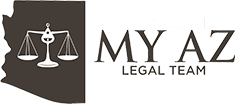Bankruptcy
(602) 900-9834 – Hire a Phoenix Arizona Bankruptcy Lawyer Today
Filing for bankruptcy protection can eliminate your debt, prevent foreclosure or repossession of assets, and halt any pending lawsuits or wage garnishments.
Filing for bankruptcy protection is one way by which consumers can free themselves from the weight of mounting debt. While filing for bankruptcy protection once carried a negative stigma, it is now considered a prudent financial decision for many. Under the Bankruptcy Code, consumers may be able to eliminate unsecured debt (credit card debt, medical bills, personal loans), remove certain liens from secured assets, stop wage garnishments and levies, prevent foreclosure, and eliminate creditor harassment.
Article I Section 8 of the United States Constitution authorized congress to create a uniform set of laws regarding bankruptcy. This ??ankruptcy Code?? was enacted in 1978 and provides a means by which consumers and businesses can file for bankruptcy protection and protect against the ramifications of unmanageable debt.There are 6 different types of bankruptcy protection provided by the Bankruptcy Code. Most consumer bankruptcy filings fall into two of these categories: Chapter 7 (Liquidation Bankruptcy) and Chapter 13 (Reorganization Bankruptcy).
Chapter 7 Bankruptcy??? Also known as ??iquidation??Bankruptcy, Chapter 7 Bankruptcy involves the liquidation of a debtor?? non-exempt asset for distribution to creditors in exchange for elimination of most unsecured debt. Chapter 7 allows for certain property exemptions (primary residence, car, household goods) that protect specified property from the bankruptcy estate. For this reason, most Chapter 7 debtors retain most or all of their personal property. Income requirements (means test) limit who can file bankruptcy under this chapter.
Chapter 13 Bankruptcy??? Chapter 13 Bankruptcy???Also known as ??epayment??bankruptcy, Chapter 13 bankruptcy requires a debtor to enter into an income-based repayment plan with their creditors for a period of 3 to 5 years. At the end of this plan, remaining debt may be eliminated. Chapter 13 allows debtors to retain valuable property that is not protected under the Chapter 7 Bankruptcy exemptions. Chapter 13 Bankruptcy is also an option for those consumer debtors that do not qualify for Chapter 7 Bankruptcy under the means test.
Other chapters of the bankruptcy code are briefly described below. However, it is important to understand that these are less common due to their strict eligibility requirements and usually do not apply to most consumer bankruptcy filings.
Chapter 11 Bankruptcy ?? Also known as ??eorganization??bankruptcy, Chapter 11 is commonly used by commercial enterprises to repay creditors while continuing normal business operations. Under Chapter 11, a business files a plan of reorganization that allows repayment of some obligations, discharge of some debts, and the termination of certain contracts or leases. The goal is to reorganize the business, allowing return to profitability.
Chapter 15 Bankruptcy ?? Chapter 15 of the Bankruptcy Code provides a mechanism for dealing with something called ??ross-border insolvency,??when a debtor is subject to the laws of another country in addition to the laws of the United States.
Chapter 12 Bankruptcy Chapter 12 Bankruptcy ??Chapter 12 Bankruptcy is the adjustment of debts of a family farmer of fisherman with regular annual income. The process of Chapter 12 Bankruptcy is very similar to that of Chapter 13, in which a debtor enters into a repayment plan with their creditors to repay a portion of their debt. The typical repayment duration under Chapter 12 Bankruptcy is 3 years and operation of the farming or fishing business can continue while the plan is carried out.
Chapter 9 Bankruptcy ?? Also known as ??djustment of Debts of a Municipality,??Chapter 9 allows municipalities to file for a reorganization of debts. This process is limited to cities, towns, villages, counties, municipal utilities,and school districts.
Why File Bankruptcy?
The decision to file bankruptcy should not be taken lightly. However for many residents of Arizona, the decision to file bankruptcy may be a prudent one.
In addition to bankruptcy, there are numerous options for those looking to escape the weight of their mounting debt. However, there are certain times when bankruptcy may be the best option:
- #1 ?? You are facing imminent foreclosure, garnishment, or lawsuit.
- #2 ?? You have previously failed to negotiate or settle your debt.
- #3 ?? You are currently unemployed and/or have little steady income.
- #4 ?? Your level of unsecured debt far exceeds your current ability to repay it.
Do I need an Attorney?
This question is addressed directly on the Arizona Bankruptcy Court Website. ??While it is possible to file a bankruptcy case ‘pro se,’ that is, without the assistance of an attorney, it is extremely difficult to do so successfully. Unincorporated associations, partnerships and corporations must appear though an attorney in Federal Court. Hiring a competent attorney is highly recommended.??
There is no law requiring consumers to hire an attorney to handle their bankruptcy filing. However, since the since the 2005 BAPCPA changes to the bankruptcy code have made fling more difficult, even the bankruptcy court system advises the use of an experienced attorney to file. The following list includes some of the benefits of hiring an attorney to handle your bankruptcy case.
- Determines eligibility to file under the different chapters of the bankruptcy code
- Reviews assets to determine whether they are protected from bankruptcy estate
- Completes and submits the extensive bankruptcy petition
- Handles creditor communication and eliminates creditor harassment
